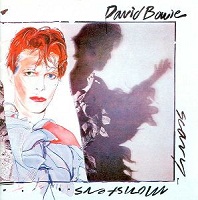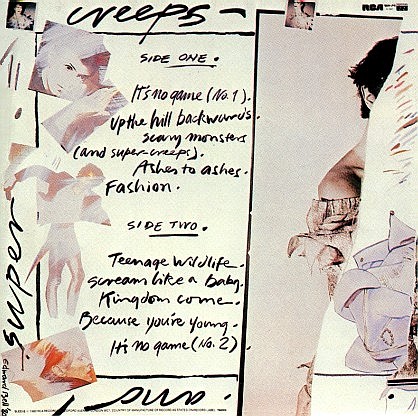- Scary Monsters (and Super Creeps)
Infobox Album
Name = Scary Monsters (and Super Creeps)
Type = studio
Artist =David Bowie

Released = start date|1980|9|12|df=yesRykodisc /EMI Reissue start date|1992|5|8|df=yes EMI/Virgin Reissue start date|1999|9|28|df=yes
Recorded = The Power Station, New York; Good Earth Studios,London start date|1980|2–end date|1980|4
Genre = Rock, New Wave,post-punk
Length = 45:08
Label = RCA
Producer = David Bowie,Tony Visconti
Reviews =
*Allmusic Rating|5|5 [http://www.allmusic.com/cg/amg.dll?p=amg&sql=10:4i66mpsk9f5o link]
*Robert Christgau (B+) [http://www.robertchristgau.com/get_artist.php?name=david+bowie link]
*"Rolling Stone Album Guide " Rating|4.5|5 [http://www.acclaimedmusic.net link]
Last album = "Lodger" (1979)
This album = "Scary Monsters (and Super Creeps)" (1980)
Next album = "ChangesTwoBowie" (1981)
Misc = Extra album cover 2
Upper caption = Back cover
Type = studio

Lower caption = Original LP rear sleeve"Scary Monsters (and Super Creeps)" is an album by
David Bowie , released in September 1980 byRCA Records . It was Bowie's final studio album for the label and his first following the so-called 'Berlin Trilogy ' of "Low", ""Heroes" " and "Lodger" (1977-1979). Though considered significant in artistic terms, the trilogy had proved less successful commercially. [David Buckley (1999). "Strange Fascination - David Bowie: The Definitive Story": p.302] With "Scary Monsters", however, Bowie achieved what biographer David Buckley called "the perfect balance", the music press heaping praise on the new album and public anticipation being high enough to see it debut in the UK charts at #1.David Buckley (1999). Ibid: pp.363-375] [Nicholas Pegg (2000). "The Complete David Bowie": p.314]Roy Carr &Charles Shaar Murray (1981). "Bowie: An Illustrated Record": pp.108-114]Production
According to co-producer
Tony Visconti , Bowie's method on "Scary Monsters" was somewhat less experimental and more concerned with achieving a commercially-viable sound than had been the case with his recent releases; to that end the composer spent more time on his own developing lyrics and melodies before recording, rather than improvising music in the studio and making up words at the last minute. Aside from one cover,Tom Verlaine 's "Kingdom Come", all tracks would be credited to Bowie alone, unlike the 'Berlin Trilogy' where he had increasingly relied on input from his collaborators.Among those collaborators,
Brian Eno was no longer present on "Scary Monsters" but, following his absence from "Lodger",Robert Fripp returned with the distinctive guitar sound he had earlier lent to "Heroes".Bruce Springsteen 's pianistRoy Bittan was back for his first Bowie album since "Station to Station " (1976), whileThe Who 'sPete Townshend guested on the bittersweet love song "Because You’re Young".tyle and themes
The public's first taste of "Scary Monsters" was "Ashes to Ashes", which was released as a single one month prior to the album and made #1 in the UK. Built around an ear-catching guitar synth theme by
Chuck Hammer , it revisited the character ofMajor Tom from Bowie's early hit "Space Oddity ". Aside from its critical and commercial success as a song, the accompanyingmusic video set a benchmark for the art form. [Nicholas Pegg (2000). Op Cit: p.29]Notwithstanding the lush textures of "Ashes to Ashes", Bowie's sound on the album was described by critics as being harsher – and his worldview more desperate – than anything he had released since "
Diamond Dogs " (1974). This was exemplified by such tracks as "It's No Game (No. 1)", the hard-rocking opener featuring lead female vocals in Japanese; the careering title track with its prominent percussion effects and Bowie’s mock-cockney accent; the second single "Fashion", which seemed to draw uncomfortable parallels between style and politics and which had its own highly-regarded video; and "Scream Like a Baby ", a tale of political imprisonment.Aside from "Ashes to Ashes", "Teenage Wildlife" was perhaps the album’s most personal lyric. Against a musical backdrop that owed much to his classic song "Heroes", Bowie appeared to take aim squarely at his
post-punk artistic godchildren, particularlyGary Numan ::A broken-nosed mogul are you:One of the new wave boys:Same old thing in brand new drag:Comes sweeping into view:As ugly as a teenage millionaire:Pretending it’s a whiz-kid world
Cover
The cover of "Scary Monsters" featured Bowie in the
Pierrot costume he wore in the "Ashes to Ashes" video, rendered in a combination of Brian Duffy's photographs and a painting by Edward Bell. The original vinyl album's rear sleeve referred to four earlier albums, namely the immediately preceding 'Berlin Trilogy' and 1973's "Aladdin Sane ", the last-mentioned also having been designed and photographed by Duffy. The cover images from "Low", "Heroes", and "Lodger" – the last showing Bowie's torso superimposed on the figure from "Aladdin Sane"'s inside gatefold picture – were portrayed in small frames to the left of the track listing. Their whitewashed look was reportedly designed "to symbolise the discarding of Bowie's old personae." [ [http://members.ol.com.au/rgriffin/GoldenYears/ScaryMonsters.html "Scary Monsters" at BowieGoldenYears] ] These images were not reproduced on the Rykodisc reissue in 1992, but were restored for EMI/Virgin's 1999 remastered edition.ingles and additional tracks
Following the release of "Ashes to Ashes" in August 1980, prior to the album, and "Fashion" in October, the title track was issued as a single in January 1981 in both vinyl record and
compact cassette form. The album's final single "Up the Hill Backwards " was released in March of that year. Other songs from this period, released on CD by RykoDisc, included both sides of the single "Alabama Song" b/w "Space Oddity", the latter a stark remake that debuted New Year’s Eve 1979 on "The Kenny Everett Video Show " and served as a "ritualistic purification" of Bowie’s most famous number prior to its demolition with "Ashes to Ashes"; "Crystal Japan ", B-side of "Up the Hill Backwards" in the UK and an A-side b/w "Alabama Song" in Japan, where it was also used for aSake commercial; and a new version of "Aladdin Sane"’s "Panic in Detroit".Release and aftermath
RCA released "Scary Monsters" in September 1980 with the promo line "Often Copied, Never Equalled", seen as a direct reference to the New Wave acts Bowie had inspired over the years. It was highly praised by critics, "
Record Mirror " giving it a rating of seven stars out of five, while "Melody Maker " called it "an eerily impressive stride into the '80s" and "Billboard" reported that it "should be the most accessible and commercially successful Bowie LP in years". [Patrick Humphrey (2007). "You've Been Around", "MOJO 60 Years of Bowie": p.79] The album's #1 placing in the UK charts was Bowie's first since "Diamond Dogs" in 1974, while its U.S. peak of #12 was his highest stateside showing since "Low" almost four years earlier.Despite the worldwide megastardom and commercial success that Bowie would achieve in coming years, most notably with his next studio album "Let's Dance" in 1983, many commentators consider "Scary Monsters" to be "his last great album", [ [http://www.allmusic.com/cg/amg.dll?p=amg&sql=10:4i66mpsk9f5o All Music Guide review] ] the "benchmark" for each new release. Later efforts, such as "Heathen" or "Reality", were often cited as "the best album since "Scary Monsters"." [ [http://www.google.com/reviews?cid=d971e29cc1e757a0&q=%22scary+monsters%22&fp=4 Google reviews] ] In the latest edition of his musical biography of the singer, "Strange Fascination", David Buckley suggested that "Bowie should pre-emptively sticker up his next album 'Best Since "Scary Monsters"' and have done with it". [David Buckley (2005). "Strange Fascination - David Bowie: The Definitive Story": p.500]
In 2000 "Q" magazine ranked "Scary Monsters" at #30 in its list of the 100 Greatest British Albums Ever. In 2002
Pitchfork Media placed it #93 in its Top 100 Albums of the 1980s.Track listing
All songs written by
David Bowie except where noted.# "
It's No Game (No. 1)" – 4:15
# "Up the Hill Backwards " – 3:13
# "Scary Monsters (and Super Creeps)" – 5:10
# "Ashes to Ashes" – 4:23
# "Fashion" – 4:46
# "Teenage Wildlife " – 6:51
# "Scream Like a Baby " – 3:35
# "Kingdom Come" (Tom Verlaine ) – 3:42
# "Because You're Young " – 4:51
# "It's No Game (No. 2)" – 4:22Reissues
The album has been rereleased four times to date on
CD , the first being in 1984 by RCA, the second in 1992 byRykodisc (containing four bonus tracks), the third in 1999 byEMI (featuring 24-bit digitally-remastered sound and no bonus tracks) and the last in 2003 by EMI as a SACD (Super Audio Compact Disc).1992 reissue bonus tracks
#
- "
Space Oddity " (single B-side, re-recorded acoustic version 1979) – 4:47
# "Panic in Detroit " (re-recorded version 1979, previously unreleased) – 3:00
# "Crystal Japan " (Japanese single A-side 1979) – 3:08
# "Alabama Song" (Bertolt Brecht ,Kurt Weill ) (UK single A-side, recorded 1978) – 3:51Personnel
*
David Bowie – vocals, keyboards, backing vocals, producer
*Dennis Davis – percussion
*George Murray – bass
*Carlos Alomar –guitar sAdditional personnel
*
Chuck Hammer –guitar/synthesizer on "Ashes to Ashes" and "Teenage Wildlife"
*Robert Fripp – guitar on "Fashion", "It's No Game", "Scary Monsters (and Super Creeps)", "Kingdom Come", "Up the Hill Backwards" and "Teenage Wildlife"
*Roy Bittan –piano on "Teenage Wildlife", "Ashes to Ashes" and "Up the Hill Backwards"
*Andy Clark –synthesizer on "Fashion", "Scream Like a Baby", "Ashes to Ashes" and "Because You're Young"
*Pete Townshend – guitar on "Because You're Young"
*Tony Visconti –acoustic guitar on "Scary Monsters (and Super Creeps)" and "Up the Hill Backwards", backing vocals, producer
*Lynn Maitland – backing vocals
*Chris Porter – backing vocals
*Michi Hirota – voice on "It's No Game (No. 1)"Charts
Album
Notes
succession box
before = "Never for Ever " byKate Bush
title =UK Albums Chart number one album
years = September 27, 1980 – October 10, 1980
after = "Zenyattà Mondatta " byThe Police succession box
before = "Xanadu"
byOlivia Newton-John and theElectric Light Orchestra
title = Australian Kent Music Report number-one album
years = October 6 – November 9, 1980
after = "Guilty" byBarbra Streisand - "
Wikimedia Foundation. 2010.
